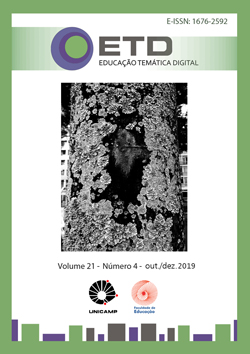Abstract
To be or not to be – that shall not be the question. In an attempt to untie ourselves, to let go of the clichés, the dyads and the stereotype of finding out what goes in ‘between’, this text seeks to make loopholes in order to allow some thinking about the Caiçara life, under the perspective of its non-finishing and its vital potentiality, which we call it ‘becoming-caiçara’. The stories told about the caiçaras often tie them to tradition and to a ‘place’, bordered by boundaries that delimit what ‘must’ be ‘inside’ and what ‘should’ be ‘outside’ of their culture, as well as what they ‘should do’ and what ‘they should not do’. In this course the bet is placed on what is being named here as a “quasi-environmental-education”, as a way to refer to the experimentations and processes involved in the making of realities via photographs and narratives that refer to memories and ungraphed forgetfulness photos, which shall not represent stories or given realities, but ‘present’ us ‘with possibilities’ of other realities, different, strange and unknown. Records of passages and passengers that, often, are no longer and live no longer, not being seen or not willing to be shown. Photographs and narratives made in meetings and absences, foreseen and unforeseen.
References
ADAMS, Cristina. As populações caiçaras e o mito do bom selvagem: a necessidade de uma nova abordagem interdisciplinar. Revista de Antropologia, SP, v. 43, n. 1, 2000. Disponível em: http://dx.doi.org/10.1590/S0034-77012000000100005. Acesso em: 14 jul. 2019.
BARROS, Laura P. de; KASTRUP, Virgínia. Cartografar é acompanhar processos. In: PASSOS, Eduardo; KASTRUP, Virginia; ESCÓSSIA, Liliana da. Pistas do método de cartografia: pesquisa-intervenção e produção de subjetividade. Porto Alegre, RS: Sulina, 2015. 207p. ISBN 978-85-205-0530-4
DELEUZE, Gilles. Que és un dispositivo? In: E. Balibar, H. Dreyfus, G. Deleuze et al. Michel Foucault, filósofo. Barcelona: Gedisa, 1999. 444p. ISBN 978-8474323894
GODOY, Ana. A menor das ecologias. São Paulo: Editora da Universidade de São Paulo, 2008. 366p. ISBN 85314108X
GUIMARÃES, Leandro B. Uma leitura entre a floresta e a escola: um livro, uma década. In: PREVE, Ana Maria; GUIMARÃES, Leandro B. BARCELOS, Valdo; LOCATELLI, Julia. Ecologias inventivas: conversas sobre educação. Santa Cruz do Sul: EDUNISC, 2012. 371p. ISBN 4783436
GUIMARÃES, Leandro B.; SAMPAIO, Shaula M. V. Educação ambiental nas pedagogias do presente. Em aberto. Brasília, v. 27, n. 91, 2014. Disponível em: http://emaberto.inep.gov.br/index.php/emaberto/article/view/2425. Acesso em: 15 jan. 2019.
LEITE, Amanda M. P. Fotografias para ver e pensar. 2016. Tese (Doutorado em Educação) -Programa de Pós-graduação em Educação, Universidade Federal de Santa Catarina, Florianópolis, 2016.
MASSEY, Doreen. Pelo espaço: uma nova política da espacialidade. Rio de Janeiro: Bertrand Brasil, 2008. 312 p. ISBN 978-85-286-1307-0
MONGE. Ricardo M. “Nascido e criado”: a ocupação tradicional da Família dos Remédios, uma comunidade “caiçara” – Península da Juatinga, município de Paraty/RJ. 2012. Dissertação (Mestrado em Ciência Ambiental) - Programa de Pós-Graduação em Ciência Ambiental, Universidade Federal Fluminense, Niterói, 2012.
PELBART, Peter. O avesso do niilismo: cartografias do esgotamento. 2. ed. São Paulo: n-1 Edições, 2017, 448p. ISBN 978-85-66943-25-2
SAMPAIO, Shaula. M. V. "Uma floresta tocada apenas por homens puros..." Ou do que aprendemos com os discursos contemporâneos sobre a Amazônia: narrativas sobre populações tradicionais e seus saberes sobre a natureza. Tese (Doutorado em Educação) - Programa de Pós-graduação em Educação, Universidade Federal do Rio Grande do Sul, Porto Alegre, 2012.
SPINK, Mary Jane. Os métodos da pesquisa como linguagem social. Estudos e Pesquisas em Psicologia, Rio de Janeiro, v. 2, n. 2, 2003. Disponível em: https://www.e-publicacoes.uerj.br/index.php/revispsi/article/view/7754. Acesso em: 10 jan. 2019.
VAZ, Tamiris. Devir-descarte: habitar transbordamentos. ClimaCom, Campinas, ano 5, n. 11, 2018. Disponível em: http://climacom.mudancasclimaticas.net.br/?p=8992. Acesso em: 12 dez. 2018.
VIANNA, Lucila P. De invisíveis a Protagonistas: populações tradicionais e unidades de conservação. São Paulo: Annablume/Fapesp, 2008. 339p. ISBN 978-8574198521
WUNDER, Alik. Fotografias como exercícios de olhar. In: REUNIÃO ANUAL DA ASSOCIAÇÃO DE PÓS-GRADUAÇÃO E PESQUISA EM EDUCAÇÃO (ANPED), 29., 2006, Caxambu, MG. Anais do... Caxambu, MG: ANPED, 2006. Disponível em: http://29reuniao.anped.org.br/trabalhos/trabalho/GT16-2359--Int.pdf . Acesso em: 10 jan. 2019.
The ETD - Digital Thematic Education uses the Creative Commons license (CC), thus preserving the integrity of the articles in an open access environment.


